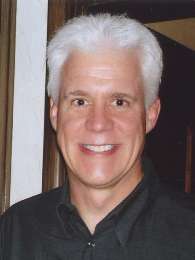Eric N. Olson
Eric Newell Olson (born September 27, 1955 in Rochester, New York[1]) is an American molecular biologist. He is professor and chair of the Department of Molecular Biology at the University of Texas Southwestern Medical Center in Dallas, where he also holds the Robert A. Welch Distinguished Chair in Science, the Annie and Willie Nelson Professorship in Stem Cell Research, and the Pogue Distinguished Chair in Research on Cardiac Birth Defects.[2]
Eric N. Olson | |
|---|---|
 | |
| Born | September 27, 1955 |
Biography
Dr. Olson grew up in North Carolina and attended Wake Forest University, receiving a B.A. in Chemistry and Biology, a Ph.D. in Biochemistry, and an honorary doctorate. After postdoctoral training at Washington University School of Medicine, he began his scientific career at MD Anderson Cancer Center in Houston. In 1995, he founded the Department of Molecular Biology at The University of Texas Southwestern Medical Center in Dallas.
Eric Olson has dedicated his career to deciphering the mechanisms that control development and disease of the heart, cardiovascular system and skeletal muscle tissue. He and his colleagues discovered many of the key transcription factors and mechanisms responsible for cardiac gene regulation and formation of the heart and other muscles. His work provided a genetic blueprint for tissue formation and unveiled the molecular underpinnings of congenital and acquired diseases of the heart. Olson also discovered epigenetic mechanisms and microRNAs as regulators of muscle development and disease.
Olson is among the most highly cited researchers, with his publications cited over 90,000 times in the literature.[3][4] He has trained numerous students and postdoctoral fellows, many of whom are emerging as the next generation of leaders in cardiovascular biology.
Dr. Olson co-founded multiple biotechnology companies to translate basic discoveries into new therapeutics for muscle disease. He was co-founder of Myogen, Inc., a biotechnology company focusing on therapies for heart muscle disease. In 2007, he co-founded miRagen Therapeutics, which is developing new therapeutics for cardiovascular disease, based on microRNAs.[5] In 2015, he founded Exonics Therapeutics, which is working to correct Duchenne muscular dystrophy and other muscle diseases by genome editing.[6]
In his spare time, Eric Olson plays guitar and harmonica with The Transactivators, a rock band inspired by the Texas icon, Willie Nelson, who created the Professorship that Olson holds.[7]
Awards and honors
- 1998 Fellow, American Academy of Arts and Sciences
- 1998 Edgar Haber Cardiovascular Medicine Research Award, American Heart Association
- 1999 American Heart Association Basic Research Prize
- 1999 Gill Heart Institute Award for Outstanding Contributions to Cardiovascular Medicine
- 1999 Elected to U.S. National Academy of Sciences [8]
- 2000 Pasarow Award in Cardiovascular Medicine
- 2000 NIH MERIT Award
- 2001 Elected to the Institute of Medicine of National Academy of Sciences
- 2003 Founding Distinguished Scientist Award, American Heart Association
- 2003 Louis and Artur Lucian Award for Research in Cardiovascular Diseases, McGill University
- 2005 Outstanding Investigator Award, International Society for Heart Research (ISHR)
- 2005 Pollin Prize for Pediatric Research, Columbia University
- 2008 American Heart Association Research Achievement Award
- 2009 LeFoulon Delalande Grand Prix Awarded by the Institut de France and French Academy of Science
- 2012 Passano Award, Passano Foundation
- 2013 March of Dimes Prize in Developmental Biology, March of Dimes [9]
- 2016 Eugene Braunwald Academic Mentorship Award, American Heart Association [10]
Selected publications
- Edmondson, D.G. and Olson, E.N. 1989. A gene with homology to the myc similarity region of MyoD1 is expressed during myogenesis and is sufficient to activate the muscle differentiation program. Genes Dev. 3, 628-640.
- Gossett, L.A., Kelvin, D.J., Sternberg, E.A. and Olson, E.N. 1989. A new myocyte-specific enhancer-binding factor that recognizes a conserved element associated with multiple muscle-specific genes. Mol. Cell. Biol. 9, 5022-5033.
- Srivastava, D., Cserjesi, P. and Olson, E.N. 1995. New subclass of bHLH proteins required for cardiac morphogenesis. Science 270, 1995-1999.
- Molkentin, J.D., Black, B.L., Martin, J.F. and Olson, E.N. 1995. Cooperative activation of muscle gene expression by MEF2 and myogenic bHLH proteins. Cell 83, 1125-1136.
- Lin, Q., Schwarz, J. Buchana, C. and Olson, E.N. 1997. Control of mouse cardiac morphogenesis and myogenesis by the myogenic transcription factor MEF2C. Science 276, 1404-1407.
- Molkentin, J.D., Lu, J., Antos, C.L., Markham, B., Richardson, J., Robbins, J., Grant, S. and Olson, E.N. 1998. A calcineurin-dependent transcriptional pathway for cardiac hypertrophy. Cell 93, 215-228.
- McKinsey, T.A., Zhang, C.L., Lu, J., and Olson, E.N. 2000. Signal-dependent nuclear export of a histone deacetylase regulates muscle differentiation. Nature 408, 106-111.
- Wang, D-Z., Chang, P., Wang, Z., Small, E., Krieg, P.A., Olson, E.N. 2001. Activation of cardiac gene expression by myocardin, a transcriptional cofactor for serum response factor. Cell 105, 851-862.
- Zhang, C.L., McKinsey, T.A., Chang, S., Antos, C.A., Hill, J.A., and Olson, E.N. 2002. Class II histone deacetylases act as signal-responsive repressors of cardiac hypertrophy. Cell 110, 479-488.
- Shin, C.H., Liu, Z.P., Passier, R., Zhang, C.L., Wang, D.Z., Harris, T.M., Yamagishi, H., Richardson, J.A., Childs, G., and Olson, E.N. 2002. Modulation of cardiac growth and development by HOP, an unusual homeodomain protein. Cell 110, 725-735.
- Olson, E.N. 2006. Gene regulatory networks in evolution and development of the heart. Science 313, 1922-1927.
- van Rooij, E., Sutherland, L.B., Qi, X., Richardson, J.A., Hill, J., and Olson, E.N. 2007. Control of stress-dependent cardiac growth and gene expression by a microRNA. Science 316, 575-579.
- Williams, A.H., Valdez, G., Moresi, V., Qi, X., McAnally, J., Elliott, J.L., Bassel-Duby, R., Sanes, J.R., and Olson, E.N. 2009. MicroRNA-206 delays ALS progression and promotes regeneration of neuromuscular synapses in mice. Science 326, 1549-1554.
References
- https://www.biochem2.com/pdf/perspectives_Lectures/Medicine/Olson/OlsonCV.pdf
- "Biographical Sketch"
- "Google scholar"
- "Web of Knowledge"
- "miRagen Company Founders Archived 2011-05-18 at the Wayback Machine"
- "Exonics Therapeutics"
- "ASBMBtoday Science Focus "Heart Matters""
- "National Academy of Sciences"
- "March of Dimes Prize in Developmental Biology"
- "Eugene Braunwald Academic Mentorship Award"